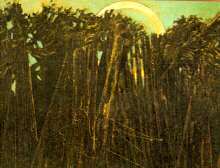In the summer of 1933 Ernst was spending a holiday right in
Vigoleno having been invited by theDuchess of Grammond, who
in the 1920's had restored the castle to its antique splendors,
hosting important personalities of the artistical and cultural world.
"In the castle's dining-room- remembered Ernst in an interview
pubblished in June 1971 by Bolaffi arte- there was a very ordinary
looking S.Giorgio hanging on the wall. So I went to Milan to buy a
canvas of the same measurements. I painted that "Foresta" in just
a day. Maria was very frightened, she was afraid that I would paint
her a stupid surrealistic painting, but in front of the result she
became enthusiastic."
The Duchess of Ruspoli got her intuition right regarding the
greatness of Ernst's work of art; the painting, a canvas oil painting of 162x253,
is today preserved in Houston (Menil Collection), it's a
"frottage" in which the perfect blend of green, yellow and blue of
the trees in the foreground with the blue and emerald green of the
sky creates a mystic and
spooky atmosphere.
There is a bird in front of the vegetation, which is often present in
the pictures of Ernst, it's "Loplop" " a game of the imagination",
claimed the artist. The picture painted at Vigoleno inspires a
second observation; in fact it was the castle's workers that gave Ernst's canvas painting
the
name "La foresta imbalsamata", a title which it still holds today.
That year the actors of the Scala performed Verdi's Aida at
Busseto, "in the land where the great composer was born, the
performance was magnificent", exclaimed Ernst. In the third act of
the Aida is the duet Aida-Amonastro, in which Amonastro
describes the perfumed woods of his native town to his
daughter:"You will once again see the close-knit forests, the fresh
valleys..." The castle's workers, who had assisted in the
presentation of the work of art, when they saw it exclaimed:"La
foresta imbalsamata!".
"People with an innocent outlook on things-said Ernst-have no
problem in seeing things as they really are. It was in this way that
the picture obtained its title".
The artist of "Oedipus Rex" of the amazing visions like "The Angel
of the house", "The dressing of the bride" and the "Temptation of
St.Antonio", got to know and appreciate the sweet and soft serenity of the "Piacentini" hills, of its inhabitants, castles and culture,
leaving a strong and unerasable trace of his genius, with a tribute
that very few places can boast about.

